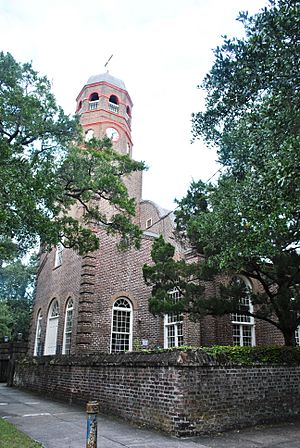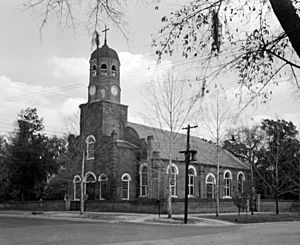Prince George Winyah Parish Church facts for kids
Quick facts for kids Prince George Winyah (Anglican) and Churchyard |
|
|---|---|
 |
|
| Religion | |
| Affiliation | Anglican |
| District | Anglican Diocese of South Carolina |
| Leadership | The Reverend Gary N. Beson |
| Status | Active |
| Location | |
| Location | Corner of Broad and Highmarket Sts., Georgetown, South Carolina |
| State | South Carolina |
| Architecture | |
| Completed | c. 1750 |
| Specifications | |
| Spire(s) | 1 |
| Materials | Brick with stone trim |
| U.S. National Register of Historic Places | |
| Added to NRHP | May 06, 1971 |
| NRHP Reference no. | 71000783 |
| Website | |
| http://www.pgwinyah.org/ | |
The Prince George Winyah Parish Church is an Anglican church located in Georgetown, South Carolina. Anglican churches are part of a worldwide Christian family. This church is special because it's one of the oldest churches in South Carolina that has been used continuously since it was built.
The church and its grounds, called the Churchyard, were added to the National Register of Historic Places on May 6, 1971. This means it's recognized as an important historical site.
Contents
Building the First Church
As more people moved into the South Carolina Lowcountry long ago, there was a need for new churches. The Prince George Parish was officially started on March 10, 1721. It was named after the Prince of Wales, who later became King George II of Great Britain.
At first, there were two ideas for where to build the church. One was further inland on the Black River. The other was closer to the coast, in a place called Winyah, near the Sampit River and Winyah Bay. This coastal spot is where the city of Georgetown is today.
In 1726, a wooden church was built inland, about twelve miles from where Georgetown is now. However, this first church was later moved to a new parish called St. Frederick's Parish in 1734.
The Church We See Today
The church records for Prince George Winyah start from January 13, 1737. People began collecting money in 1737 to build a new church in Winyah. They also got money from a tax on goods brought into the port and a large sum from the colonial government.
Bricks for the new church started to be gathered in 1740. Land for the church was given by William Screven, who was the first Baptist minister in Carolina, and his son Elisha Screven. Construction began in the mid-1740s. The first stone, called the cornerstone, was placed on October 30, 1745.
Church Design and Features
The church was built using red bricks from England and a special mortar made from local oyster shells. The main part of the church, called the nave, is shaped like a rectangle. It has five sections, with side doors in the middle sections and windows in the others. All these openings have fanlights, which are windows shaped like a fan.
Brick columns, called pilasters, decorate the sides of the doors and the corners of the church. The roof over the main worship area is sloped, and the entrance has a unique gable style. Inside, the nave has a curved ceiling that looks like a barrel.
The church has old-fashioned wooden box pews, which are like enclosed seating areas. There's a main aisle down the middle and another aisle that crosses it near the side doors. The floor is made of flat stones called flagstone. The very first church service in this building was held on August 16, 1747.
Changes Over Time
During the American Revolutionary War, British soldiers took over the church. They burned the inside, and some stories say they even used it as a stable for horses.
Around 1809, a new section called a chancel was added. This part has a rounded end, known as an apse, and a balcony. In 1824, a front entrance with double doors and a tall tower was built. The brick tower has a square base, then an eight-sided section on top with a small dome and a large cross. The upper part of the tower holds a clock and a bell tower with a railing. A Mohler organ was put in the church in 1850.
In 1823, Francis Huger Rutledge became a deacon here. He later became a bishop in Florida. In 1828, Anthony Toomer Porter, who started a school in Charleston, was baptized at the church.
During the American Civil War, the Union Navy took control of Georgetown on February 25, 1865. However, the church remained open.
In 1871, the church updated the chancel area and made the altar larger. In 1874, the church received a new bell and a clock. A beautiful stained glass window from another chapel was also installed.
In 2012, Prince George Winyah Church decided to separate from the older Episcopal Church. It then joined a more traditional group called the Anglican Church in North America.
The Churchyard Cemetery
The churchyard is surrounded by a brick wall and includes a cemetery. Many people who were part of the church, including its leaders, are buried here.
Some important people from South Carolina are also buried in this cemetery. These include Paul Trapier, who was a patriot during the American Revolution, and James H. Trapier, a general in the Confederate Army. Also buried here are Rev. Dr. Anthony T. Porter and Governor Robert Francis Withers Allston.


